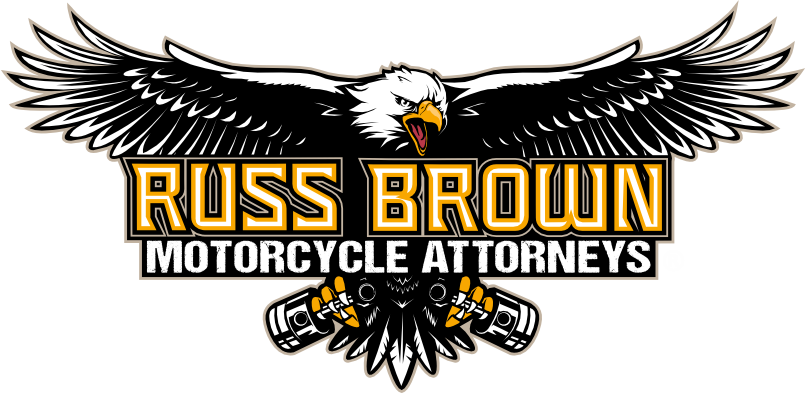ARIZONA Motorcycle Accident Lawyers
Contact Us Today For a Free Consultation!
Motorcycle Accident Attorneys: Russ Brown Motorcycle Attorneys® have been fighting for injured motorcyclists for decades. We are experts in motorcycle accidents and have carefully chosen local, independent counsel across the country to help guide your claim with free legal advice, even if you do not need an attorney. This can maximize your recovery. If you want justice and compensation for your injury, pain and suffering, call today for your free consultation.
Contact Us
Your ARIZONA Motorcycle Accident Lawyers
You can count on our experienced Arizona motorcycle accident lawyers to know the laws specific to your case. As a rider, you can only trust a motorcycle accident attorney that is well versed in Arizona motorcycle law. Our attorneys can give you advice regarding just what your liability may be in the bike accident, as well as what your damages and personal injury may be worth. Insurance companies make a business out of undercutting your claim—we know how to deal with their tactics better than anyone else. We will deal with your insurance agency for you, handle your damages, and make sure you get the best medical care and recovery possible. Secure the experienced advice you need and deserve by trusting your case to one of our skilled motorcycle personal injury attorneys. Whether your motorcycle accident was someone else’s fault, your fault, or whether fault is debatable – Call Russ Brown Motorcycle Attorneys® at 1-800-4-BIKERS to talk to experienced local specialists in the field who understand the laws of Arizona and how they apply to you.
Riding in arizona
Arizona is a natural setting for some of the best rides this country has to offer. Riders can enjoy riding year round in warm desert heat with all the majesty of the natural landscape ranging from canyons and mesas to urban sprawl. It’s no wonder Arizona is listed as among the top 20 states for motorcyclists to call home. Learn more about the Best Motorcycle rides in Arizona.
Given the high cost of gasoline and the sluggish economy, it’s not surprising that motorcycle ridership has continued to increase nationwide year after year. However, with ever-greater numbers of motorcycles, cars, and trucks crowding highways left vulnerable by years of budget-deferred maintenance issues, the number of motorcycle accidents in Arizona continues to rise. If you should experience an accident, call 1-800-4-BIKERS and you will get the backing of Arizona’s toughest motorcycle accident attorneys, in addition to the consulting resource of Chuck Koro & Jim Romag, nationally recognized for their expertise in motorcycle cases.
The Grand Canyon State has much to offer motorcyclists and has been one of the more active states for enforcement of motorcycle safety laws. Riders here especially benefit from authorities’ awareness and diligence regarding distracted drivers and DUI enforcement. Still, motorcycle crashes continue to occur on our roadways with worrisome frequency. To reduce the chances of a motorcycle accident it is important to be aware of Arizona motorcycle safety laws.
If your family has been touched by a serious motorcycle accident anywhere in Arizona, you should contact a motorcycle accident attorney immediately. Please call Russ Brown Motorcycle Attorneys® at 1-800-4-BIKERS to schedule your free consultation today.
Arizona Motorcycle Accident Lawyer FAQ
What is the process for making a claim for personal injuries and property damage when someone is involved in a motorcycle accident in Arizona?
Every case is different, so we develop a unique strategy to maximize each client’s financial compensation. Your claim is either resolved by way of settlement or jury trial. A settlement can be reached before a lawsuit is filed or after filing a lawsuit. In some instances, we file suit right away because the insurance company is denying responsibility, or our experience tells us that the insurer has a reputation for not paying top dollar until we show them that we are ready to go to court. Many times, a settlement can be reached without the formalities and time it takes to work a case through the court system.
Unlike some personal injury law firms, we handle all aspects of both your injury claim and property damage claim. We take everything off your plate including getting your bike fixed or recovering its fair market value so your sole focus can be recovering from your injuries. This means we solely deal with both your insurance company and the insurance company for the responsible party – if a representative from either company calls you, we ask that you immediately refer them to us.
Initially, we investigate the accident, including obtaining crucial information such as police and incident reports, 911 tapes, witness interviews, and evidence of other accidents at the same location. Documenting and preserving physical evidence can be equally crucial so we formally demand that the responsible party preserve all cell phone data and the data saved to the Event Data Recorder on the responsible party’s vehicle.
Securing and photographing the motorcycle is another important part of the process because the damage to the bike can help prove how a crash occurred. Our investigators also conduct accident scene inspections to check for surveillance cameras and to measure, photograph and videotape skid marks, scrape marks, and debris fields, all of which can also be used to prove how a wreck occurred.
Despite the best efforts and intentions of law enforcement, evidence crucial to proving one or more key issues may not be included in the police or incident report and that report may not be available for weeks or months. Time is of the essence. Waiting too long to do a proper investigation can compromise your case.
Some cases require the expertise of a professional accident reconstructionist. We have used the same accident reconstructionist team for over 15 years with great success–and they ride too.
While we are investigating how your accident happened, other members of our team are busy using medical records authorizations to obtain your emergency room records and bills, so we can make a preliminary assessment of the severity of your injuries. As your medical treatment progresses, we continue to gather your medical records and bills so that the full extent of your injuries and losses can be assessed and presented to the responsible party’s insurer, along with work and earnings-related documents if you missed work or your earning capacity is affected by your injuries.
If we file a lawsuit early on, or if we file a lawsuit later in the process because the other side is unwilling to pay fair compensation, then the next step is called the “discovery” process which comes before a jury trial. Discovery gives both sides the opportunity to ask questions about the case in written form as well as conduct depositions where testimony is taken under oath in a court reporter’s presence.
Before a jury trial occurs, the parties usually agree to try to settle the case at one or more informal mediation sessions overseen by a retired judge. The case can also settle before trial at a pre-trial settlement conference held by the trial judge. A jury trial is required only after all other mechanisms for resolving the case are exhausted.
In Arizona how long does it take for a Motorcycle Accident Attorney to settle my case?
Every case is unique, and the complexity of the case affects the amount of time it takes to bring a case to resolution. Every case needs to be carefully evaluated and a strategy needs to be developed to ensure maximum compensation to the injured rider. Some cases are more straightforward than others in terms of how the wreck happened and the extent to which the rider is injured. These cases tend to resolve more quickly, sometimes in as little as a few months especially if a rider quickly recovers from their injuries. Other cases involve complicated liability issues and sometimes witnesses disagree about what they think they saw which are factors that can result in the process taking longer. Some injuries require months or even years of medical care before the full extent of the disability and need for future treatment can be determined so in these situations more time is needed to ensure that the rider is fully compensated – settling a case too soon can be a mistake. It is the Motorcycle Accident Attorney’s responsibility to make sure that the timing of the settlement occurs only when it is in the rider’s best interest and a top dollar result is achieved.
After a wreck, should I call an Arizona Motorcycle Accident Lawyer right away?
First, call 911. Next, call 1-800-4BIKERS to speak with your Arizona Motorcycle Accident Lawyer. Time is of the essence. Photographs of the scene and involved vehicles need to be taken. Skid marks and other key physical evidence can disappear with time. Witnesses need to be identified and interviewed. As time passes, witnesses can forget or confuse key facts. The accident scene needs to be scoured for video cameras that may have captured the incident or the events in the crucial seconds before. Many video cameras only save footage for a limited time. There are also strict time limits for filing a claim after which a claim is lost forever. Don’t risk compromising your case by waiting too long to call an Arizona Motorcycle Accident Lawyer.
Is Lane Splitting allowed in Arizona?
No. Lane splitting is not allowed in Arizona. However, Arizona permits lane filtering. How do lane splitting and lane filtering differ? The major difference is that lane splitting typically involves overtaking moving vehicles and lane filtering involves overtaking stopped vehicles. A rider who is lane splitting is generally thought of as travelling at or about the flow of traffic and passing and overtaking another somewhat slower moving vehicle in the same lane or riding between lanes of moving traffic or between adjacent rows of moving vehicles. Legal lane filtering in Arizona, on the other hand, must be done at no more than fifteen miles per hour and involves overtaking and passing other vehicles that are stopped in the same direction of travel and in the same lane, or riding between lanes of stopped traffic, provided: (1) the road is divided into at least two adjacent traffic lanes in the same direction of travel; and, (2) the posted speed limit does not exceed forty-five miles per hour. Lane filtering is not allowed on freeways, and it is only permitted if the movement may be made safely. An Arizona Motorcycle Accident Lawyer can answer any questions you have about the differences between lane splitting and lane filtering.
Does Arizona have a motorcycle helmet law?
Arizona law only requires motorcycle operators and passengers under the age of 18 to wear a helmet. The helmet must be safely secured. Although Arizona does not state that motorcycle helmets must be DOT-certified, this is the recommendation of the National Highway Traffic Safety Administration. Regardless of age, the operator of a motorcycle must wear protective glasses, goggles, or a transparent face shield unless the motorcycle is equipped with a protective windshield.
If you choose not to wear a motorcycle helmet, can it have a negative effect on your bodily injury claim if you are in a wreck in Arizona?
Yes, it can. Arizona law does not require a motorcycle helmet unless you are under the age of 18 years. But if you are in a wreck caused by another that results in a traumatic brain injury, concussion or other head injury and you are not wearing a helmet, the insurance company will likely take the position that you too were negligent and that not wearing a helmet resulted in more serious injuries. The insurance company can make this argument because Arizona is a pure comparative negligence state. This means that Arizona law requires the trier of fact – a judge or jury – to apportion fault between the other party and the helmetless rider based on their relative degree of culpability. The rider’s damages, including future medical bills and pain and suffering which can be significant in a brain injury case, are reduced in proportion to the extent to which the rider’s injury would have been lessoned by wearing a helmet. By way of example, if a jury initially assessed a rider’s damages at $5 million but that the severity of the rider’s brain injury would have been 50 percent less had the rider worn a helmet, the jury would be instructed to reduce the rider’s damages by 50% from $5 million to $2.5 million. This is called apportionment. These cases typically require an Arizona Motorcycle Accident Lawyer to work in conjunction with a helmet expert and a bio mechanist to help counter the insurance company’s claim that wearing a helmet would have lessened the rider’s injuries to begin with.
How can Arizona’s pure comparative negligence law benefit Arizona motorcycle accident victims?
In 1984, an Arizona statute did away with the doctrine of contributory negligence and adopted the doctrine of pure comparative negligence. What is the difference and how can the latter help injured Arizona motorcyclists?
The difference between these two doctrines is straightforward.
The contributory negligence doctrine states that an injured party who also fails to act with ordinary care – one who is also negligent – is completely barred from receiving any compensation for their injuries. So, under contributory negligence law, a seriously injured rider who was operating their motorcycle at more than the posted speed limit would not be able to recover any damages from the other party who was also negligent, even if the other party was relatively much more at fault and even if the motorcyclist sustained catastrophic injuries, such as a permanent brain injury or loss of a limb.
The injustices associated with scenarios like the one just described led the way the to the doctrine of pure comparative negligence. Rather than completely barring compensation to an injured party who is also negligent, the doctrine of pure comparative negligence apportions the injured party’s fault against the fault of the other party and reduces the injured party’s recovery of damages in accordance with their proportion of fault.
In example, if the driver of a truck makes a left turn and fails to yield the right of way to an oncoming motorcyclist who is traveling 10 miles per hour over the posted speed limit, a jury would be instructed to assign the relative percentages of fault to both parties– he total being 100%. In such a situation, a jury could reasonably determine the driver of the truck was 90% at fault and the motorcyclist was 10% at fault. The motorcyclist’s total damages would therefore be reduced by 10%.
Unfortunately, not all Arizona motorcycle victims are aware that the law of pure comparative negligence allows them to recover at least a portion of their damages in situations even where their percentage of comparative fault is equal to or greater than the fault of the other party. This could mean that a catastrophically injured rider who was as much as 99% at fault for a wreck can still recover some amount of damages.
It is important that Arizona motorcycle accident victims contact an Arizona Motorcycle Accident Attorney to see if they have a valid claim even if they were partially at-fault and the police report is not in their favor.
What is the time limit for making a claim following a Motorcycle Accident in Arizona?
Arizona law sets maximum time limits for initiating a claim after a wreck. These time limits are called statutes of limitation. There are different statutes of limitation that can apply depending on the facts. You should contact an Arizona Motorcycle Accident Attorney as soon as possible to determine which limitations period is applicable because if the time for initiating a claim is exceeded, your ability to recover damages will be forever lost.
When a motorcycle accident results in personal injury, generally speaking, the statute of limitations is two years from the date the accident occurred. This means that you must file a lawsuit with the court no later than two years after you were hurt. The court will dismiss your case if your lawsuit is filed late.
Arizona statute of limitations law imposes a much shorter deadline when a claim is being made against a public entity or a public employee. In these cases, the injured party must file claims with the person or persons authorized to accept service for the public entity or public employee within 180 days of the wreck. Claims filed after the 180-day deadline are barred. The claim submission must set forth facts sufficient to put the public entity or public employee on notice of the basis upon which liability is asserted. The claim must also include a specific dollar amount for which the claim can be settled and the factual basis for the amount sought. A lawsuit must be filed against the public entity or public employee if the claim is not settled by the time of the one-year anniversary of the accident. If this one-year limitations period for filing suit is exceeded, the court will dismiss your case.
When a minor child is injured, statutes of limitation do not begin to run until the child reaches 18 years of age. By way of example, if a 17-year-old minor child is injured in a motorcycle accident, the two-year statute of limitations that is applicable when a non- public entity or a non-public employee is involved would not expire until the minor child’s twentieth birthday.
An Arizona Motorcycle Accident Attorney will ensure that your claim is timely filed within the applicable statute of limitations.
If a rider is injured in a motorcycle accident in Arizona, does the motorcyclist have a Tort Claim against the other party who caused the rider’s injuries?
A tort is an act or omission that causes legally recognized harm to a person or property. Typically, a motorcycle accident is the result of the negligence of the other party meaning that the other party either acted or failed to act in a way which was unreasonable under the circumstances. An injured rider has a tort claim against the other party based on the other party’s negligent act or omission. The injured rider’s physical injuries, pat an future pain and suffering, their accident-related medical bills and lost wages, and the damage to the motorcycle are among the legally recognized harms for which the injured rider may be compensated under Arizona law.
What are the most common types of injuries sustained in motorcycle accidents in Arizona?
Riding motorcycles is fun and exciting. But the feeling of being out in the open and free of the confines of a car comes with the risk of being much more seriously injured in the event of a collision. Motorcycles just don’t have the protections of other vehicles and the physics of a wreck almost never play in the rider’s favor. This can result in life-changing injuries including, broken bones, torn ligaments and tendons, spinal cord injuries, traumatic brain injuries, injuries to the lungs and other organs, and disfiguring road rash and lacerations. Maximizing the compensation you receive for your injuries depends on hiring an experienced Arizona Motorcycle Attorney who understands anatomy, physiology as well as biomechanics.
How is Compensation calculated for the Harms and Losses suffered by a Motorcycle Accident Victim in Arizona?
A motorcycle accident usually results in property damage to the rider’s motorcycle as well as bodily injuries to the rider’s person. Arizona law recognizes separate claims for property damage and bodily injury. Because a property damage claim is not lumped in with a bodily injury claim, the rider’s property damage and bodily injury claims can be settled separately.
Property damage claims include the cost to repair the motorcycle, or the fair market value of the motorcycle if the motorcycle is deemed a total loss. Additional elements of a property damage claim include towing and storage charges as well as the rider’s damaged helmet and riding gear. Arizona law also provides for loss-of-use damages for the duration of time the motorcycle is being repaired. Loss-of-use damages are calculated based on the fair rental value of a comparable motorcycle.
Bodily injury claims include compensation for both economic and non-economic losses.
Economic losses refer to quantifiable money lost and include medical bills and lost income. An injured rider is entitled to be compensated for both past and future medical bills and lost income meaning both the medical bills and lost income incurred up until the time of settlement as well as the medical bills and lost wages likely to be incurred during the remainder of the injured rider’s life.
Non-economic losses are intangible meaning they do not have a specifically identifiable monetary value such as a hospital bill or month’s pay. But losses of a non-economic nature can represent a large portion of the total bodily injury claim’s overall value. Examples of non-economic losses include physical pain and suffering, mental anguish and emotional distress, and loss of enjoyment and quality of life. An injured rider can be compensated for both past and future non-economic losses. Non-economic losses are different in every case depending upon the severity of the injuries and the individual’s circumstances. Methods for calculating non-economic damages to an injured motorcyclist should be left to a seasoned law firm specializing in highlighting subjective losses due to motorcycle crashes so that no area of financial recovery is overlooked or undervalued.
An experienced Arizona Motorcycle Accident Attorney can assure that an injured rider receives maximum compensation for all elements of their harms and losses, both past and future.
In Arizona, what are the most common types of motorcycle accidents and what are their causes?
Most common are motorcycle accidents occurring at intersecting roadways. Another common type of motorcycle accident occurs when the other driver is changing lanes. Many of these accidents occur because the other driver is unable to see the rider such as when something is obscuring the other driver’s view. In this type of scenario, the other driver commonly turns or moves from their lane of travel when it is unsafe to do so. Drivers can also see the motorcycle but fail to properly judge its speed or distance which can leave the rider with insufficient time to brake or take other evasive maneuvers. It is also common for the other driver to look but fail to see the rider even though the rider is in plain sight. Many times, the other driver looks quickly or while distracted which can account for an otherwise very visible rider not being seen. According to human factors experts, sometimes the other driver looks but fails to see the rider because the human eye has what’s called a narrow zone of clear visual focus which, in non-technical terms, means that when your eyes are focusing on single object, you tend to have a diminished ability to see things in your peripheral vision. This can explain how a left-turning driver can be looking in the direction of an oncoming motorcycle yet still fail to detect it if the driver was focused on another oncoming vehicle in the motorcycle’s immediate vicinity. Insurance company lawyers may try to use this as a defense when the other driver carelessly turns in front of you, so it is important to hire an Arizona Motorcycle Accident Attorney experienced with these issues.
When there is an injured passenger in a motorcycle accident, against whom should the claim be made?
Since the passenger is negligence-free, he or she can pursue a claim against all involved drivers, including the driver of the motorcycle. As you might imagine, under some circumstances, you as a passenger may be faced with a tough decision on whether to pursue a claim against your own driver. However, in order to receive compensation for your injuries adequate to cover your medical expenses, it may be necessary.
In the situation where the motorcycle rider is fully at fault, the passenger will also have to proceed against his own driver if he wants to recover. This is a difficult decision and some passengers simply choose not to take any action against their own driver. Others understand that the funds are paid from the driver’s insurance company, not the driver himself, and agree to proceed against those funds only. It should be noted that usually, the claim cannot be made against a family member or if both are on the same insurance policy.
Looking for the best arizona Motorcycle
Attorneys near you?
Motorcycle Accident Attorneys
in Other States
We Ride – We Care – We Win!









